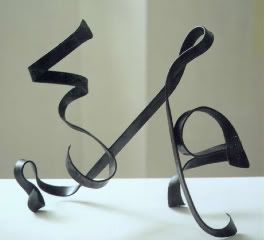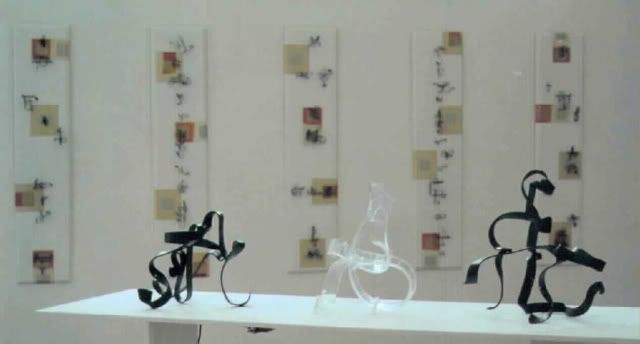To digress for a moment; I flaunted that boundary between art and craft back then. As a loose definition within the Art School; a material or method which leant itself (at least historically) to making practical useful objects was a 'craft', on the basic idea that crafts generally follow a repeatable pattern, meaning anyone can do it. That's not to say that Art is 'Decorative' (which was yet another virtual curse word, indicating your art was all surface fluff with little challenge of thought in its design.) So for many mediums there was a significant challenge in breaking out of the craft label; textiles and ceramics being the most obvious.
A piece from my final body of work titled 'Anagram' 2001
The medium that really sang for me at the time was blacksmithing, which
is on that art/craft boundary to begin with. In the month or two before
starting my final body of work I'd started exploring calligraphy
(calligraphy is definitely a 'craft' in the Western world), and somehow
the two tunes just harmonised beautifully in my head. Calligraphy in a
3D form, casting shadows, emulating various languages yet saying
nothing. With the added bonus that I could make it beautiful and fake the pretentious art wank.
A collection of my works from my final assessment 2001, my 3D scrolls in the background
So, back to the subject.
Art vs Craft, Process vs Product.
In Art for children they are able to take the invitation offered and create something of their own devising; to make their own whimsical mark on the world. As a teacher you can Inspire them, but you can't control their creation (by definition it's their creation, not yours).
In Craft their personality makes minimal impact on the final look of the piece. This may be due to everyone having to glue this just like that to make identical little mice, or it may be because the mark the medium makes leaves little room for child direction.
Think for a moment. How much control does a child have when blowing bubbles in a cup of ink before taking a print of it? Or rolling a marble around in a flat bottomed tub with some paint and a sheet of paper? How much creative value and thought actually goes into these expressions?
(Photo credit: the crayola website: http://www.crayola.com/crafts/detail/bubble-prints-craft/)
The more control we offer a child over the marks they make, the greater the creative value.
To this end I want to do a series of posts of some of the wildly creative play I've gotten up to with the children in my care. I'm limited in that I can't post pictures of children (I may have to block them out in some shots). I'll be tagging them under 'Meaningful Art' and hopefully it'll become a useful resource for others.



No comments:
Post a Comment